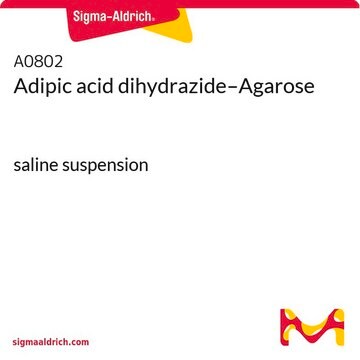A0638
Adipic acid dihydrazide
≥98% (titration)
Synonym(s):
Hexanedihydrazide
About This Item
Recommended Products
Assay
≥98% (titration)
form
powder
reaction suitability
reagent type: cross-linking reagent
mp
180-182 °C (lit.)
solubility
H2O: 100 mg/mL
storage temp.
−20°C
SMILES string
NNC(=O)CCCCC(=O)NN
InChI
1S/C6H14N4O2/c7-9-5(11)3-1-2-4-6(12)10-8/h1-4,7-8H2,(H,9,11)(H,10,12)
InChI key
IBVAQQYNSHJXBV-UHFFFAOYSA-N
Looking for similar products? Visit Product Comparison Guide
General description
Application
- in the preparation of reactive premix to synthesize the porous biomaterial
- for the crosslinking of methacrylated chondroitin sulfate (MA-CS) coating using carbodiimide-based chemistry for the production and characterization of methacrylated chondroitin sulfate magnetic nanoparticles (MA-CS MNPs)
- for the covalent labeling of rhamnolipids, pyochelin, and vancomycin with Abberior STARNHS ester dye
Biochem/physiol Actions
Other Notes
Hazard Statements
Precautionary Statements
Hazard Classifications
Aquatic Chronic 2
Storage Class Code
11 - Combustible Solids
WGK
WGK 3
Flash Point(F)
302.0 °F - closed cup
Flash Point(C)
150 °C - closed cup
Personal Protective Equipment
Certificates of Analysis (COA)
Search for Certificates of Analysis (COA) by entering the products Lot/Batch Number. Lot and Batch Numbers can be found on a product’s label following the words ‘Lot’ or ‘Batch’.
Already Own This Product?
Find documentation for the products that you have recently purchased in the Document Library.
Customers Also Viewed
Our team of scientists has experience in all areas of research including Life Science, Material Science, Chemical Synthesis, Chromatography, Analytical and many others.
Contact Technical Service











